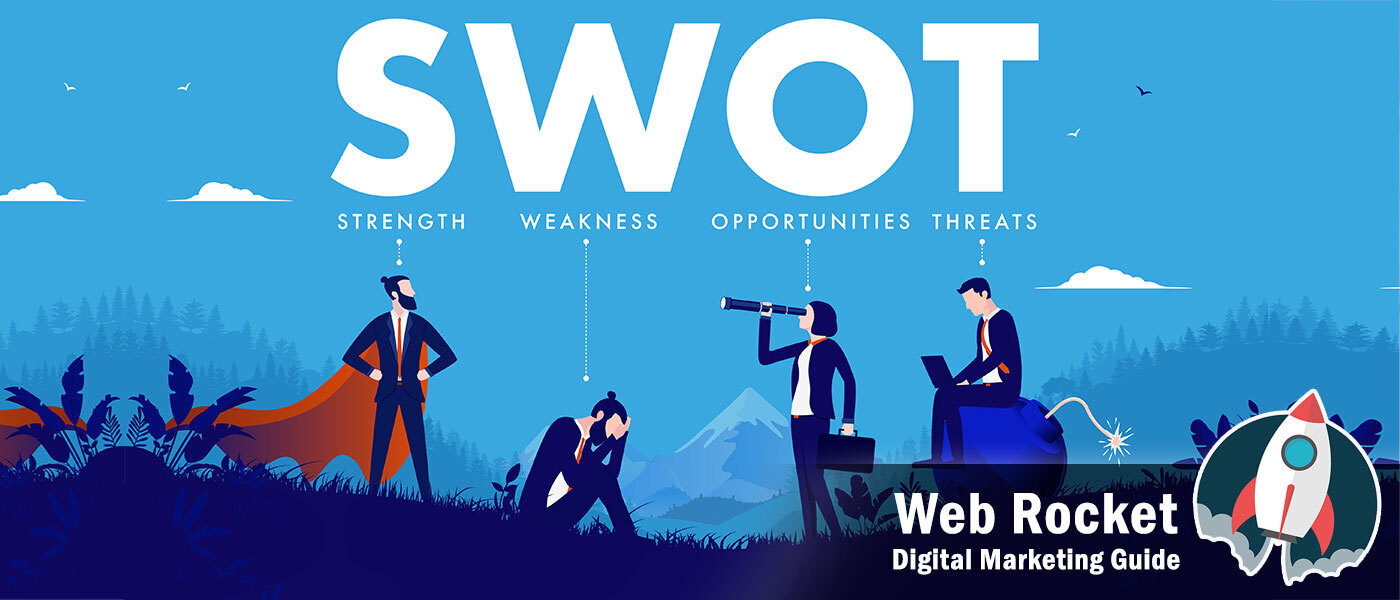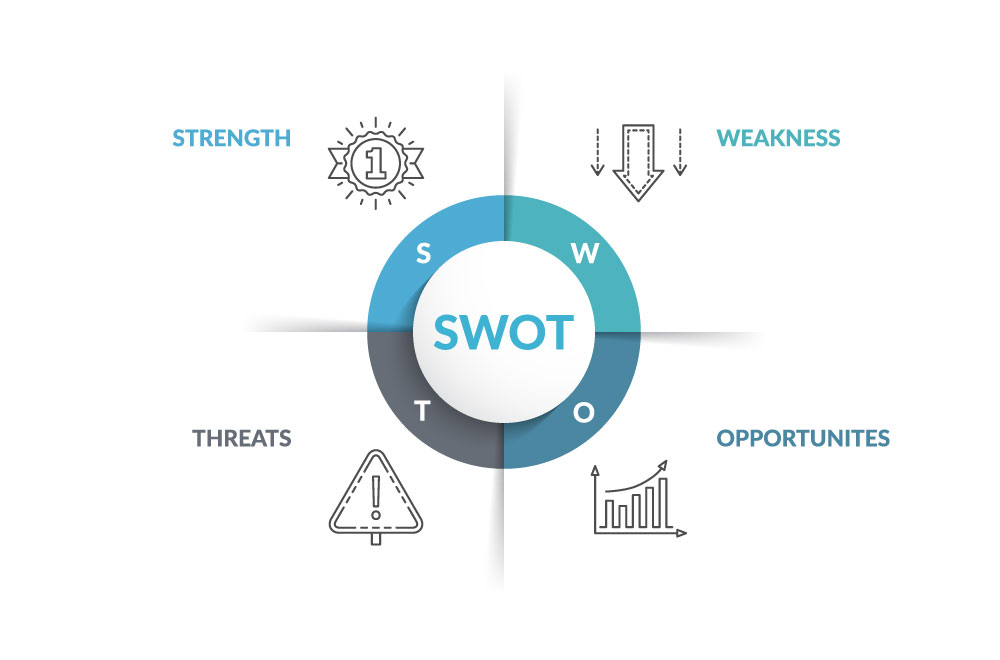How to do a SWOT Analysis for your business

What is a SWOT Analysis (Strengths, Weaknesses, Opportunities, and Threats)?
A SWOT analysis (Strengths, Weaknesses, Opportunities, and Threats) is a simple technique for assessing these four key aspects of your business. It serves to reflect on both internal and external factors, highlighting what your company does best currently, and to outline a successful strategy for the future.
This analysis can also reveal flaws in your current way of working, promoting and operating, giving you insight into how to remedy these issues. SWOT can also reveal areas of the business that may impact growth and progression, or that your competitors could exploit if you don't protect yourself.
This beneficial assessment tool can be used to understand the competitive dynamics of a business within an industry. It helps us understand the current direction of the business and factors which affect it, presenting both opportunities and challenges.
SWOT analysis, alongside competitive research, can help to understand a company’s position relative to other participants in the industry. It helps to build an idea of the present and future scenario of the industry.
What can we learn from a SWOT Analysis?
- How your business is performing well and what others see as strengths
- Factors that may leave your business vulnerable in the marketplace or industry
- Problems or opportunities facing your company
- Your performance, reputation and growth, respective to your competitors
- Industry or market factors that may impact your business
- Factors that affect the promotion and sales of your services and products
With this critical information, we can better plan the direction and activities of our business.
How to do a SWOT Analysis
To perform a useful SWOT Analysis, we recommend getting together with key members of your team, each from different parts of your business. Include everyone from product and service roles, branding and marketing, customer relations, business planning and training.
The more perspective you have on the business, the more valuable this tool will be.
Once you have everyone together, simply draw up a quadrant grid, with each of the 4 sections labelled accordingly - Strengths, Weaknesses, Opportunities, and Threats.
Once you have this in place, you can begin to make notes on each of the sections through active discussion with your team. For each section, we have summarised below, some of the questions and factors you should be considering.

Strengths
- What does your company do well?
- What gains a positive reaction from customers?
- What actions are creating a positive impact on your business?
- Are there unique resources or features of your business which stand out amongst your competitors?
These are just a few of the considerations for the strengths of your business. Evaluate everything that you are currently doing well.
This could include aspects such as customer service, staff training, keeping down costs, promotional activities, product/service quality. You should look at your company in fine detail. For example, do customers report that your staff are friendly, informative, and helpful? Do users have a positive experience on your website? All of these factors are important and contribute to your overall strengths if they are executed effectively.
Let's take a look at some example strengths:
- Strong branding and reputation
- Website is easy to use, generating strong conversions
- Customer service reviews are positive
- Access to suppliers is consistent and reliable
- Overheads are low due to small number of staff
Weaknesses
- What does your company need to improve?
- Are there any aspects of your business that cause complaints or lower customer retention rates?
- Where do you struggle for resources, engagement or customer acquisition?
- Are your staff performing to optimum standard, and is the quality of your services and products satisfying your customers?
It is just as significant to understand your weaknesses as a business to devise actionable steps to improve on them.
Again, it's important to look at your internal processes as well as reactive factors such as customer satisfaction and brand engagement. What other people see as weaknesses will potentially be different from what you see, so be sure to collect valuable opinion based information and put it to good use to improve.
Let's take a look at some example weaknesses:
- Low presence on social media, reducing exposure
- High dependence on a few key staff causing vulnerability
- Cash flow at early stages of business is limited
- New staff training is limited due to time restrictions
Opportunities
- What opportunities are available for you to enhance your strengths and improve your weaknesses?
- What trends are currently in play which may benefit your business?
- Which resources and facilities may enhance your offering?
There will always be a number of positive factors that can assist in the growth and development of your business. It is important to be aware of what is happening in your industry and supporting landscape to drive your business forward. Think about promotional opportunities that you may be able to take advantage of to demonstrate your strengths. Possible training and support that may improve your weaknesses. There may be tech or IT systems available that may improve your customer service and management. Streamlining and improving your processes is always a positive action which can ripple benefits through your company.
Let's take a look at some example opportunities:
- Free social media platforms available to generate exposure
- CRM platform available to manage customer databases and utilise for email marketing campaigns
- Government grants for small businesses to ease cashflow issues
- Ecommerce software to take payments online and manage customer purchases
Threats
- What factors or activities can pose the threat of a negative impact on your business?
- What are your competition doing that may overshadow or impact you?
- Are there industry trends that may affect your sales or customer acquisition?
- Are there new products coming to market that may replace your own?
Keeping an eye on possible threats to your business is extremely important. Being aware of both internal and external factors that may cause problems allows you to plan to combat these issues. Threats can exploit your current weaknesses and may be detrimental to your existing strengths.
Be sure to evaluate what is going on around you and have a clear idea of what you can do to reduce any impact on your business.
Let's take a look at some example threats:
- New competitors entering the marketplace frequently
- Supplier costs increasing, placing a strain on cashflow
- Large scale marketing campaigns from main competitors
- New product development acting as an alternative to your offering
How to use your SWOT Analysis
Once you have evaluated your strengths, weaknesses, opportunities and threats, we need to put that information to good use. We need to produce actionable responses and steps to each of the points raised and understand how to use the information to our advantage.
For example, if a STRENGTH is “strong branding and reputation”, our actionable step would be to build this into our promotional activities. Create eye-catching social media posts, perhaps containing a positive review alongside the company logo. Use that strength and shout about it. Add positive customer reviews and testimonials to your website, and be sure to thank your customers for their kind words.
If a WEAKNESS is “low presence on social media”, it's time to get active and remedy that. Schedule in 15 minutes each day to begin with to create a post, answer a question in a discussion group or make an announcement. You can build on this with your social media strategy moving forward.
Is there an OPPORTUNITY to “streamline your business with new CRM Software?” Nothing is better than getting organised. Make steps to compare available CRM software packages that may help your staff perform more efficiently and choose the one that is right for you.
Is there a THREAT of “large scale marketing campaigns from competitors?” Evaluate what they are doing and how they are reaching customers. See how you can build on your own marketing uniquely to offer something they can't. Look at where they are promoting and see if you can target alternative areas.
SWOT Analysis in Summary
Understanding the dynamics of both internal and external factors impacting your business is key. With a strong, detailed SWOT analysis you can plan, build and perform much more effectively.
- Strengths: What are you currently doing well? How can you use this to your advantage?
- Weaknesses: Where do you currently struggle to perform well? What steps can be made to improve?
- Opportunities: What is available to you to help build and improve your business? How can you take advantage of these opportunities to build your strengths?
- Threats: What factors may impact your business in a negative way? How can you prepare to combat these issues?
As you can see from the SWOT Analysis, there are a broad scope of factors that impact the successful running of any business. It is important to have a rounded understanding of these factors to enable us to build our business, perform to our optimum and deliver our services to customers effectively.
This information also assists us in planning for the future and how to combat issues which may arise. We highly recommend conducting a SWOT Analysis as part of your Business Plan.
Blog Categories
Become a guest blogger
Do you have an article to post about Digital Media & Marketing? Maybe Design or Social Media is your passion?
If so we'd love to hear from you.
Looking for a new website?
If you are looking to develop a new website for your business, why not get in touch and have a chat through your project.
We'll provide you with a free quote and website specification to assist with your planning.



















